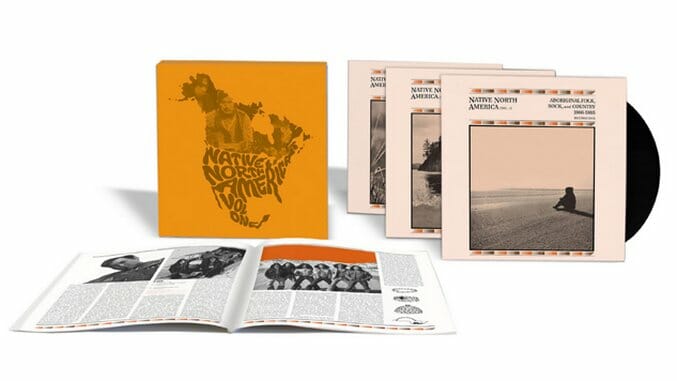8 Artists Exploding the Concept of Native American Music

Native American music may be one of the most tragically unknown genres in American music today. Representing civilizations and cultures that date back thousands of years (some predating ancient Egypt), the music and folkways from these centuries have been passed on directly to today’s musicians. Despite the weight of this history, there’s still a huge divide between the music being made by Native artists and the level of interest within North American public and/or media.
Part of the issue here lies with Native communities who have been relentlessly exploited by non-Natives. These communities are understandably leery about letting outsiders record and profit from their art. The Makah Natives in Washington State, for example, have a radically advanced framework of intellectual copyright dating back millennia that keeps their music and dance from being recorded and disseminated. But most of this comes from racism and ignorance, keeping Native issues and cultures out of the mainstream. But, there’s a remarkable movement among Native artists to push ancient traditions forward, to make new words for a new era. Here are eight Native artists that you need to know about.
1. Tanya Tagaq
Perhaps one of the best known artists on this list, Tanya Tagaq is huge in her native Canada and recognized internationally, as well, having collaborated with artists like Björk and The Kronos Quartet. What’s remarkable is that she’s made her name performing Inuit vocal games known as “Inuit throat singing.” Originally, the strangely-otherworldly vocals of these games were improvised, usually among two women sitting face-to-face (faces almost touching), and were meant as a kind of game to make a sound so strange and ridiculous that it made the other person collapse in laughter. Throat singing is a cultural thread that ties the Inuit and Arctic people together from Canada’s Nunavut (where Tagaq comes from), across the top of the world to Greenland, even to Japan’s Ainu population. Tagaq deconstructs this vocal game, taking it to places never imagined and making it into a larger statement about modern Native art and Native rights. Her new album, Retribution, is slated for release this October and it focuses on the horrible abuses of First Nations women in Canada as well as on the destruction of the environment (the Inuit are at ground zero for climate change) and on the historical damage done to First Nations culture.
2. A Tribe Called Red
Also well known in Canada and gaining ground in the United States, this three-person Ottawa Cree collective rep Native hip-hop hard. And they’re not the only ones; hip-hop is huge in Native communities across North America. A Tribe Called Red is one of the most innovative groups, and recent work included Yasiin Bey (Mos Def) for some mainstream cred. They’ve also been pushing to the corners of Native culture in unexpected ways, like selling their original action figures inspired by Native wrestlers. The Tribe is also known for mixing in pow-wow singing with hard beats, and their new album Welcome to Halluci-Nation, which is due out this month, prominently features the Atikamekw drum group Black Bear Singers from Québec. The album also features Tanya Tagaq, who turns Inuit mouth music into a kind of beat-boxed sonic nirvana. A Tribe Called Red manage to make songs that hit hard politically and socially, but are still eminently danceable.
3. Silver Jackson
Alaska Tlingit artist Silver Jackson (Nicholas Galanin) is a bit of a renaissance man. In addition to his powerful work as a visual artist under his given name, he’s also a cutting-edge composer and sound artist and, until recently, headed up a pretty visionary community music festival called Homeskillet Fest that brought together indie rock and undergrounder hip-hop acts from the Pacific Northwest. Though Home Skillet Fest is no more, he’s turned the community into a record label producing super limited vinyl pressings. Some of this vinyl can be purchased with traditional Tlingit silver and copper bracelets that Galanin makes himself. It’s a beautiful fusion of art and music that’s the hallmark of his crew, the Black Constellation. A loose collective of groundbreaking artists of color, the Constellation blends futurist fashion and hard-hitting statements through art with hip-hop or electronic music to make something so special that galleries internationally are snapping up their work. (Galanin says he’s currently showing in 10 galleries around the world.) His art can be breathtaking and troubling at the same time; one piece was banned from the Bumbershoot Festival in Seattle (this piece depicted many Starbucks coffee cups falling to the ground and spilling blood; each cup had the name of one person of color killed by police written in Sharpie). For all this, his music as Silver Jackson is based on lush, soothing soundscapes and introspective vocals in a kind of mélange that brings to mind the luxurious forests of Sitka, Alaska, where he makes his home. This is an artist as easily at home rubbing shoulders with underground hip-hop heads and crafting digital music in powerhouse studios as he is carving a traditional Tlingit dugout canoe (the third new canoe to come out of his community in 150 years). Few artists today can fuse tradition and innovation as elegantly as Silver Jackson.
-

-

-

-

-

-

-

-

-

-

-

-

-

-

-

-

-

-

-

-

-

-

-

-

-

-

-

-

-

-

-

-

-

-

-

-

-

-

-

-








































